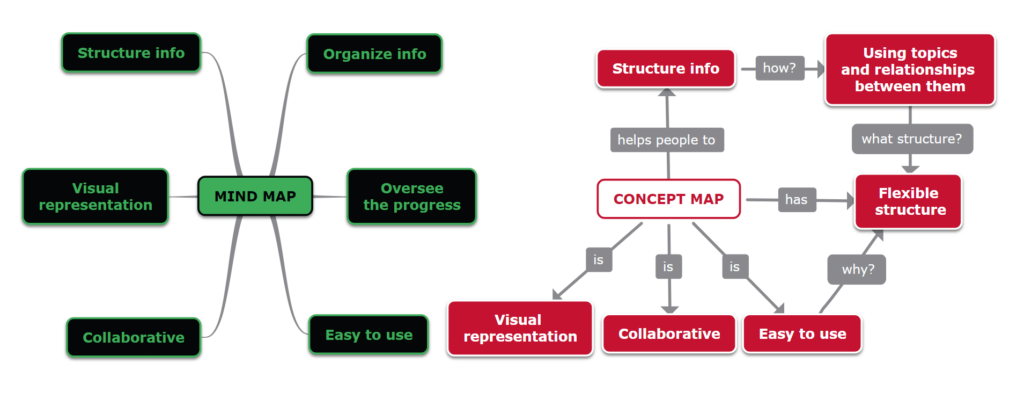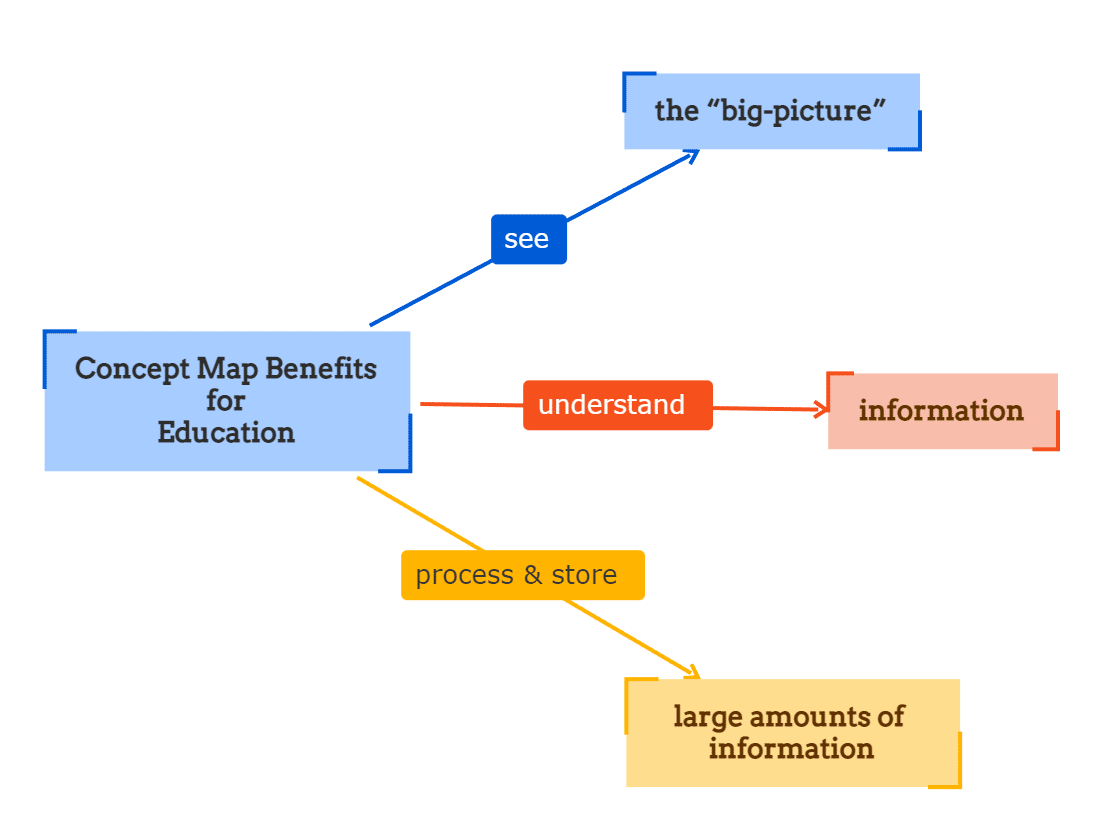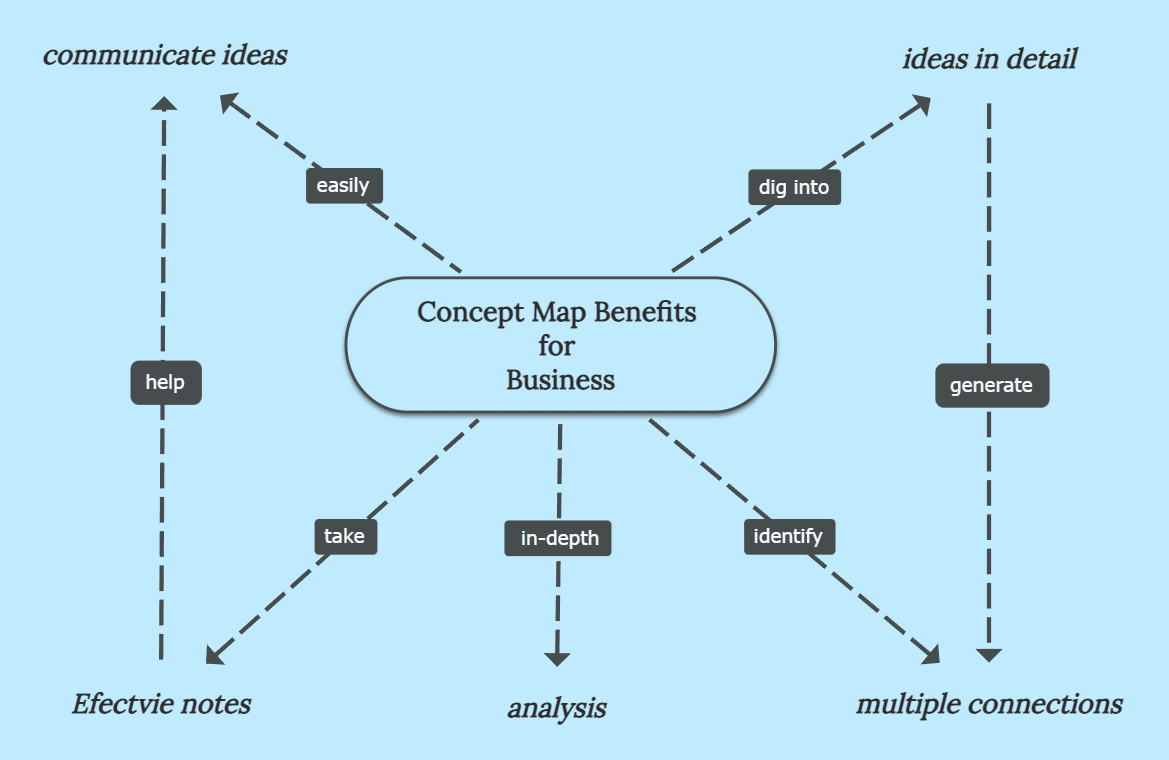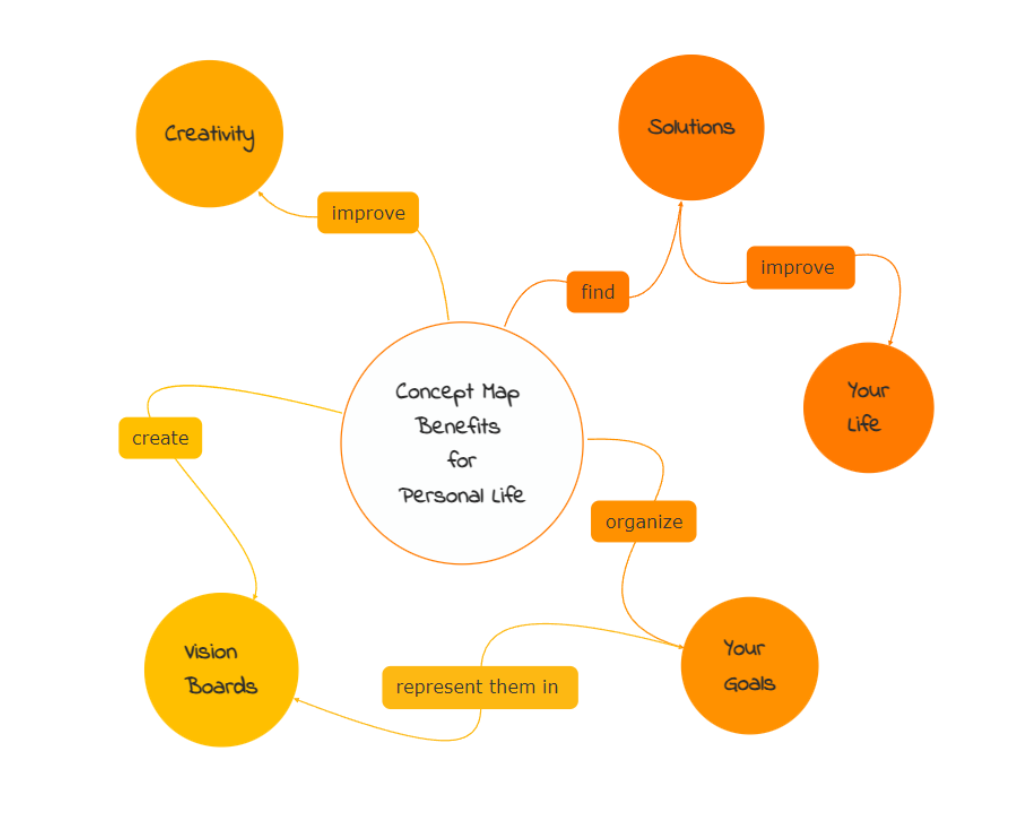What is a concept map? Simple answer: A concept map is a visual representation of knowledge, which illustrates different concepts and ideas and the relationship between them. It is also called conceptual diagram.
The concepts are represented in a hierarchical structure. Each idea is written in a box or a circle, and it is connected with other ideas by arrows. Concept mapping is a very useful tool for organizing and structuring information.
Concept Map vs Mind Map

Both concept maps and mind maps are graphical representations and they are commonly confused by many people. They resemble each other having topics and connecting lines, but there are a few major differences.
Differences between mind maps and concept maps:
➡️ Firstly, in a concept map, the relationships between concepts are explained. There are labeled arrows that link the concepts and they describe the relationships between ideas.
However, in a mind map, there are connecting lines between concepts instead of arrows with labels. This way, a concept map offers you the advantage of giving a context to all the ideas. Moreover, it becomes easier to understand, especially when there is a complex structure.
➡️ Secondly, the two graphic organizers have a flexible structure, but the concept maps have the most flexible layout. You can move the concepts and ideas freely and arrange them anywhere you prefer and you can have many-to-many relationships. On the other hand, a mind map has a more rigid construction.
Similarities between mind maps and concept maps:
Both concept maps and mind maps have the basic elements of the topic maps: topics, associations, and occurrences.

Because concept maps have the associations (connecting lines) as labeled arrows, they are more suitable for illustrating complex ideas. It is easier to understand a larger amount of knowledge using concept mapping.
You can depict the processes/elements very simply. This is why they are often used in education. These maps aid meaningful learning, being a great tool which eases the understanding process.
Read here more about the differences between concept maps vs mind maps.
Key features of a concept map
Many diagrams have a similar look. Even if a lot of them have the basic structure of the topic maps, they are different. There are some key features that make each type special. Here are the elements that make the concept maps unique:
Key concepts
The concepts can be anything starting from objects, events, processes to phenomena, plans, or your favorite book. Basically, the key concepts are written on the map inside the topics. These key concepts will be connected with each other via arrows that will show the relationship between them.
Connecting words/ phrases
The relationship between concepts is represented by linking words or linking phrases. It can be one or more words. The arrows that connect the topics have a label where you can write these words or phrases. They explain and describe the association between the topics. However, they should be as concise as possible. In most cases, there are used verbs, for example “has”, “contains”, “needs”, “includes” etc.
Structure
The concept map’s structure can be characterized by 3 major elements:
1. Hierarchical structure – the diagram organizes the elements starting from the most general to more specific ones.
2. The layout is flexible – one of the differentiating factors from other topic maps is the free form structure. You are able to arrange the diagram from top to bottom exactly how you imagine it, without any kind of limitations. Besides the position of the topics, you can add as many relationships as you want between concepts. There is no restriction that only allows you to connect to ideas.
3. Propositional structure: two concepts are connected by one linking word (or short linking phrases). Together they become a meaningful statement. Therefore, a map is a visual representation of a set of propositions (meaningful statements) about a central topic. The fact that the linking words are in most cases verbs emphasizes the propositional aspect of this type of diagram.
Focus questions
Concept maps usually explain or illustrate a complex matter or subject. Therefore, there must be a focus question that defines the issue that these graphic organizers are trying to solve. It is important to keep in mind this focus question when you create a concept map.
Along with the hierarchical structure, it guides you to maintain a certain direction of your thoughts. Hence, you should think about these two features as reference points in the mapping process.
Cross linking
While you make a concept map you will be able to identify relationships between concepts in different domains. Those connections between concepts
are called cross links. This is why concept mapping is considered a technique that facilitates creative thinking, not only improving the understanding and learning processes.
Concept mapping benefits
Why use concept maps?
The human brain processes visual information better than any other type of information. To be more precise, 90% of the data transmitted to the brain is visual. Consequently, concept mapping is a very efficient technique. Moreover, it is very simple to use and you can also have fun while creating one. You can use it for different purposes and domains:
Concept mapping for education

Concept mapping encourages a high level of thinking and it’s an amazing learning tool. Meaningful learning can be sustained by it. Structuring the information in this type of diagram allows you to understand everything easier. It is a great tool for students. They can use it for taking notes, text summaries, or learning complicated concepts.
Besides meaningful learning, these diagrams also have major benefits in memorizing. Because it is visual, it is easier for the brain to retain the information. This way, learning for exams can be simple and fun.
Concept maps are amazing for the little kids too. When you use online software, you can easily insert images or videos into your diagrams. Therefore, they can learn the animals, colors, or other simple concepts and ideas this way, finding them easy to remember. When you mind map online you also get the advantage of having easy access to all the mind maps which can be shared in seconds with the students.
Teachers can also benefit from this technique. A general concept can be explained to the students. The classes don’t have to be boring having a linear speech. Presenting information like this, you can notice a big difference. The level of attention and retention of information compared to prior knowledge presented as a regular course can surprise you!
Concept mapping for business

Being productive and efficient is important when it comes to working. Structure your tasks and to-do lists into a concept map and work smarter. Moreover, you can present project ideas to your team and make them understand better how you see things. The linking words or linking phrases will make everything clear and you can save a lot of precious time by avoiding pointless explanations. This way, the diagram provides clear communication no matter how complex the ideas may be.
The cross links can help you and your team members to think outside the box.
You can create a concept map to plan business meetings, manage processes, make analyses, organize files, structure HTML pages, problem solving, etc.
Concept mapping for personal life

Unleash your creativity and generate new ideas! Concept mapping is one of the best ways to become more creative and teach your brain to find ideas and solutions faster. Make brainstorming sessions starting from a general concept and see where your mind takes you!
Concept maps started to be amazing tools for personal development. Besides sparking creativity, these maps can help you grow as a person and improve your life significantly.
Create vision boards or simply set some new personal goals, learn more about your passions or improve your time management.
Always keep in mind the focus question (doing this already helps you have an organized direction of your thoughts). The cross links can make you think about some aspects from different perspectives, ones you’ve never looked at before.
How to create a concept map?
Concept maps are so amazing but how can you create one?
There are a few simple steps you need to follow to create your concept maps:
Step 1: Create a central topic with the main concept (the subject/title of your map). Make it a word or a short phrase. If you’re using software, you can also add a suggestive image.

Step 2: Continue to add more ideas related to your main concept. Let your brain be inventive! Create relationships between these concepts and write the linking phrases on the labels. Continue to add more ideas to these ideas and so on.


Step 3: Customize the map as you like. Play with colors, fonts, shapes, sizes to add your personal touch.

Some mind mapping software allows you to add notes, links, icons, images, video, or audio files to your concept maps. This way, you have more valuable information with a minimalist design.
You can create concept maps from scratch, or start using a concept map template to get inspired.